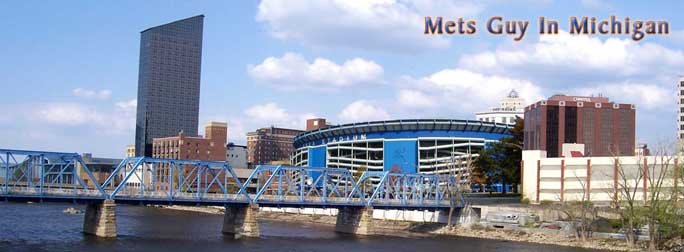 Listen closely, and you can hear Madonna sing "This Used to Be My Playgound."
Listen closely, and you can hear Madonna sing "This Used to Be My Playgound."I’m going to flip Josh Pahigian’s book back a few pages.
He tapped the Cardinal Gibbons School in Baltimore as spot no. 46 in the "101 Baseball Places to See Before You Strike Out."
That’s where Babe Ruth was sent as a youngster, when it was named St. Mary’s Industrial School for Boys, and served as an orphanage and reform school.
The original building burned in 1930s, and the Bambino helped raise money for a new building. It closed in the 1950s, reopened in the 1960s as Cardinal Gibbons. It’s a Catholic secondary school today.

We didn’t go there during our stop in Baltimore, but I offer up something right here in Grand Rapids.
Alternate Place No. 46 A) South High School, former home of the Grand Rapids Chicks.And it’s where President Gerald R. Ford went to school, too.
I’ve been interested in the All-American Girl’s Professional Baseball League since the early 1990s.
There’s a chance I ticked off my editors in Flint because I kept proposing sports stories. Might not seem like a bad thing, except that I covered schools and local governments.
But in 1991 I bravely pitched one story I suspected they couldn’t resist.
Rickey Henderson was about to break Lou Brock’s record of 939 career stolen bases, and be, as you know "the greatest of all-time."
Except that I knew he wasn’t.

The professional record of 1,114 bases belonged to Sophie Kurys of the Racine Bells. And, best of all, she was from Flint.
I found the "Flint Flash." at home in Scottsdale, Ariz. and was thrilled to hear stories about the league. This was before the movie "A League of Our Own," and not too many people knew about the AAGPBL.
She sent a note a few weeks later thanking me for the story. She liked it — mostly. I could have sworn she said she might watch Henderson break Brock’s record on television if it wasn’t too late at night.
But Kurys chided me, saying she would never fall asleep watching baseball. I was torn between being crushed and pledging allegiance.
Since the movie, some of the players make the rounds at major baseball card shows and All-Star Game FanFests, signing autographs and telling wonderful stories. I always check out their booth to see of Kurys is among the signers.
We moved to Grand Rapids in 1999, and I’ve always thought it was neat that the city hosted one of the teams — and a good one, too.
The franchise originated in 1944 in Milwaukee, won the championship, moved to Grand Rapids and made the playoffs every year until the league folded following the 1954 season.
The team had some great players. Pitcher Connie Wisniewski earned her nickname "Iron Woman" because in 1945 she started 46 games, and finishing with a 32-11 record. She was named "Player of the Year."
Gabby Ziegler earned the honor in 1950, and was one of the league’s longest-serving players.
My wife found a neat Chick’s pennant for me, and the Public Museum of Grand Rapids once had a whole exhibit dedicated to the league.
But I’ve always wondered where the team played. Some sleuthing revealed that they played at South High, except for 1950-1952, when games were played at Bigelow Field in one of the near suburbs. Bigelow Field was destroyed in a fire, and the team returned to South until 1954.
South is better-known in these parts as the place where President Ford attended classes and played football. Today it houses a Jobs Corps program named in Ford’s honor.

I had an assignment there this week, and arrived a little early so I could walk the grounds and see what was left of the stadium where the Chicks played.
Nothing.
There were some rather untended fields, but nothing left of the bleachers or anything else that would lead someone to think that professional baseball was played on the site.
There were two backstops, but I have no idea where the original diamond was situated.

I was surprised, because Grand Rapids does a good job of recognizing its history. We even have a marker noting that we were the place were fluoride was first added to the drinking water.

Old South High does have some neat features. This stone pattern surrounds the door to the auditorium.


















